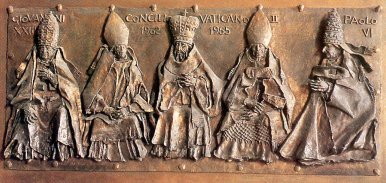Fifty Years Later
FIVE POPES AT ONE
COUNCIL (November
1962)
Never before
in the long history of the Church’s twenty ecumenical, world-wide Councils, had
five Popes – present and future -- been gathered together in one Council aula.
They were
present in St. Peter’s Basilica during Vatican II’s first session (October to
December, 1962) : the Pope who called the Council; the Cardinal who would be
elected Pope and bring the Council to its completion; two diocesan Bishops who
would also become Popes; and a young priest-theologian who, fifty years later,
presides as Pope over a “Year of Faith” to commemorate the
Council.
Pope John XXIII (Angelo Guiseppe
Roncalli) was nearly 77 years old when elected Pope in 1958. Thought to be a mere “care-taker”, he stunned
the Church when – within the first 100 days of his papacy -- he called for a
Council. Born to poor parents in a small
village, one of 13 children, he was ordained in 1904, serving as his Bishop’s
secretary and as a chaplain in the Italian army. A scholar of Church history, he became head
of the Propagation of the Faith in Italy
and, beginning in 1925, spent nearly three decades as a diplomat of the
Holy See to Bulgaria, Turkey, Greece, and finally France. In 1953, Pope Pius XII created him Cardinal
Patriarch of Venice. He succeeded Pius
as Pope, his papacy lasting only four –
eventful -- years. Acclaimed for his
“goodness”, he was beatified -- as Blessed John XXIII -- in the year 2000.
Giovanni Battista Cardinal Montini,
Archbishop of Milan, was born in 1897, ordained in 1920, and – always in frail
health - spent almost his entire priesthood in the Roman Curia, working closely
with Pope Pius XII. While in Milan, he
was created the “first” Cardinal of John XXIII, and succeeded him in 1963 –
taking the name Pope Paul VI. Montini had been an important figure at
the Council’s first session (John XXIII kept him close, with residence in the
Papal apartments) and Papa Montini guided the Council’s last three sessions.
Sometimes described as “Hamlet-like”, he
was perhaps too quickly and unfairly berated for his 1968 encyclical letter Humanae Vitae (On Human Life). Paul died
in 1978 –after 15 years as Pope.
Bishop Albino Luciani was, in 1962, the
50-year-old Bishop of Vittorio-Venetto. Consecrated a Bishop by Pope John
himself, he had been a professor, pastor and catechist; he urged the Council to
preserve “the fundamental elements of the Faith.” At 57, he became the Patriarch
of Venice and, as Cardinal, he was elected to succeed Pope Paul on August 26,
1978, taking the names of his two predecessors as Pope John Paul I. Known as “the smiling Pope,” he held that
“the Church that comes out of
the Council is still the same as it was yesterday, but renewed. No one can ever
say ‘We have a new Church, different from what it was’”. He died on September
28, 1978 – Pope for only 33 days.
Auxiliary Bishop Karol Wojtyla
of Krakow participated in the first three sessions, returning for the fourth
as a young Archbishop. A very
active Council Father, he took part in
the debates and in the writing of the decrees Lumen Gentium (“The Dogmatic
Constitution on the Church”) and Gaudium
et Spes (“The Pastoral Constitution on the Church in the Modern World”). He
returned to his native Poland – formerly under Nazism and then under Communism -
and set about implementing the Conciliar decrees. He was created a Cardinal by Paul VI; after
the sudden death of John Paul I, Wojtyla was elected the first non-Italian Pope
in 455 years. As Pope John Paul II
he proclaimed, “Do not be afraid. Open wide the doors for Christ.”
During his 26-year pontificate, he
became a pilgrim throughout the world. He promulgated a “Catechism of the
Catholic Church”, which included the teaching of the Council. John Paul “the Great” died in 2005
and was beatified in 2011.
Father
Josef Ratzinger – 35
year old German priest and professor of dogmatic theology -- was the main peritus (expert)
to Cardinal Frings of Cologne and, like Cardinal Wojtyla, was a major influence on the writing of several of
the Council documents. A decade after
the Council, he was called away from academia to become the Cardinal Archbishop
of Munich, and then called to Rome in 1981 to head the Congregation for the
Doctrine of the Faith, working closely with John Paul II for over 20 years. At age 78, he was elected Pope, taking the
name Benedict XVI. His vision of the Council is the Church’s
“renewal
and continuity” (rather than its “discontinuity and rupture”) -- the Church
which “grows in time and develops, remaining however always the same, the one
People of God on their way.”
With that understanding of
ecclesial continuity, one might say they were “all” present at Vatican II: Pius XII… Pius XI … Benedict XV … Pius X …
Leo XIII … Pius IX … back to Trent … to Ephesus … to Peter and Paul meeting in
Jerusalem.
-- Monsignor John T. Myler
-- Monsignor John T. Myler










